ESP MAZDA MAZDA 2023 Service Manual
[x] Cancel search | Manufacturer: MAZDA, Model Year: 2023, Model line: MAZDA, Model: MAZDA MAZDA 2023Pages: 623, PDF Size: 15.08 MB
Page 573 of 623
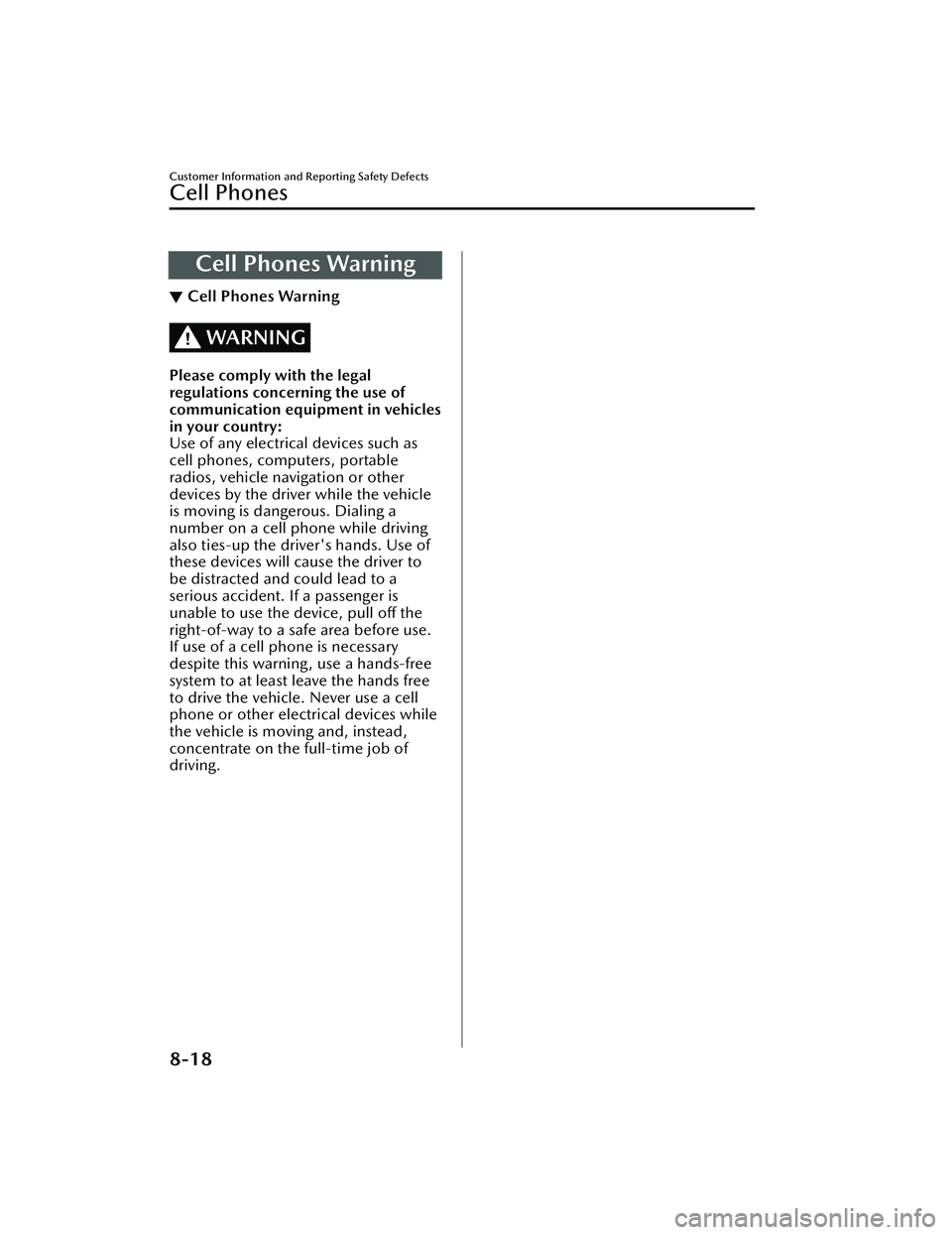
Cell Phones Warning
▼Cell Phones Warning
WARNING
Please comply with the legal
regulations concerning the use of
communication equipment in vehicles
in your country:
Use of any electrical devices such as
cell phones, computers, portable
radios, vehicle navigation or other
devices by the driver while the vehicle
is moving is dangerous. Dialing a
number on a cell phone while driving
also ties-up the driver's hands. Use of
these devices will cause the driver to
be distracted and could lead to a
serious accident. If a passenger is
unable to use the device, pull off the
right-of-way to a safe area before use.
If use of a cell phone is necessary
despite this warning, use a hands-free
system to at least leave the hands free
to drive the vehicle. Never use a cell
phone or other electrical devices while
the vehicle is moving and, instead,
concentrate on the full-time job of
driving.
Customer Information and Reporting Safety Defects
Cell Phones
8-18
Mazda3_8LC2-EA-22G_Edition1_new
2022-5-20 11:26:10
Page 576 of 623
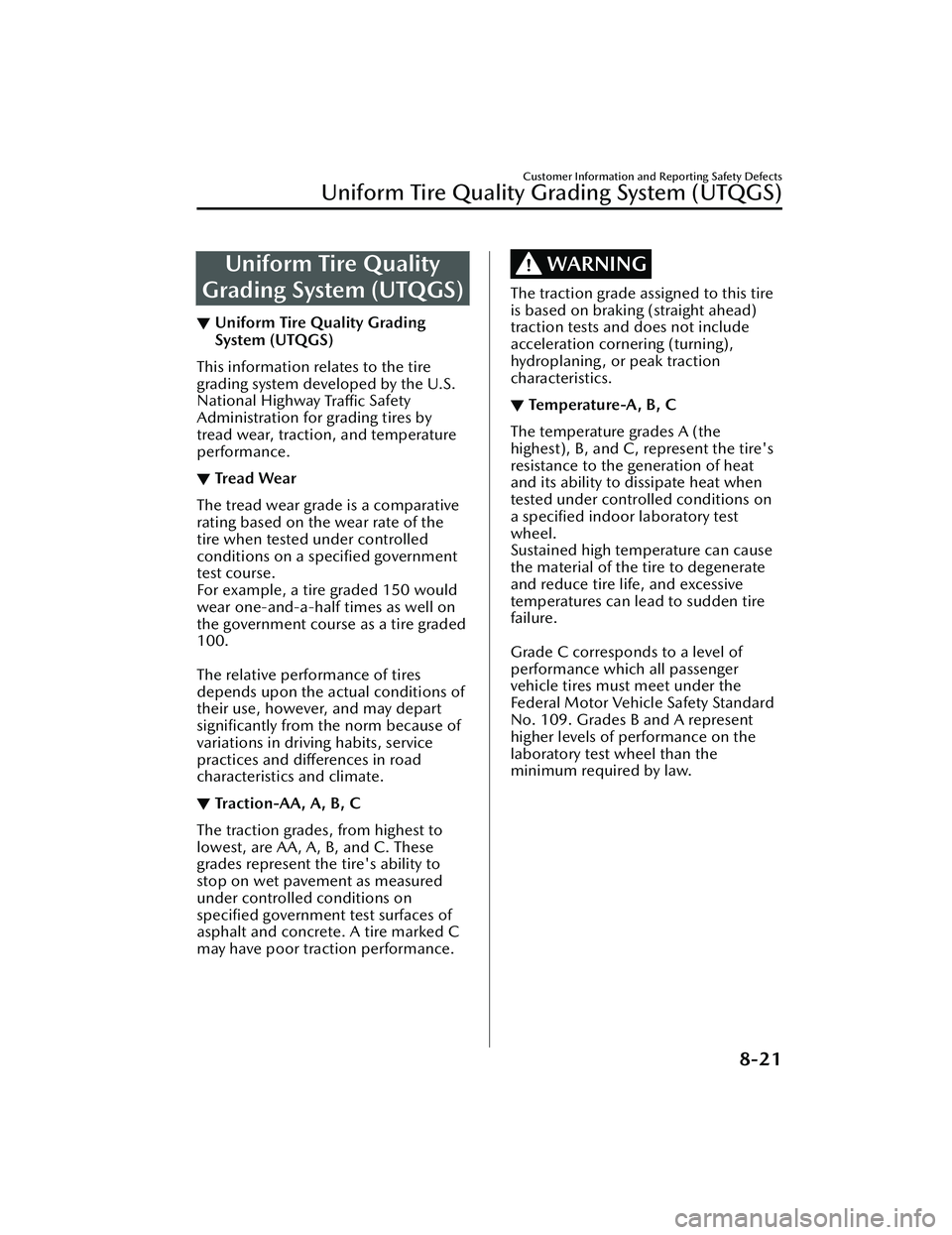
Uniform Tire Quality
Grading System (UTQGS)
▼ Uniform Tire Quality Grading
System (UTQGS)
This information relates to the tire
grading system developed by the U.S.
National Highway
Tra ffi c Safety
Administration for grading tires by
tread wear, traction, and temperature
performance.
▼ Trea d Wea r
The tread wear grade is a comparative
rating based on the wear rate of the
tire when tested under controlled
conditions on a specified government
test course.
For example, a tire graded 150 would
wear one-and-a-half times as well on
the government course as a tire graded
100.
The relative performance of tires
depends upon the actual conditions of
their use, however, and may depart
significantly from the norm because of
variations in driving habits, service
practices and differences in road
characteristics and climate.
▼
Traction-AA, A, B, C
The traction grades, from highest to
lowest, are AA, A, B, and C. These
grades represent the tire's ability to
stop on wet pavement as measured
under controlled conditions on
specified government test surfaces of
asphalt and concrete. A tire marked C
may have poor traction performance.
WARNING
The traction grade assigned to this tire
is based on braking (straight ahead)
traction tests and does not include
acceleration cornering (turning),
hydroplaning , or peak traction
characteristics.
▼Temperature-A, B, C
The temperature grades A (the
highest), B, and C, represent the tire's
resistance to the generation of heat
and its ability to dissipate heat when
tested under controlled conditions on
a specified indoor laboratory test
wheel.
Sustained high temperature can cause
the material of the tire to degenerate
and reduce tire life, and excessive
temperatures can lead to sudden tire
failure.
Grade C corresponds to a level of
performance which all passenger
vehicle tires must meet under the
Federal Motor Vehicle Safety Standard
No. 109. Grades B and A represent
higher levels of performance on the
laboratory test wheel than the
minimum required by law.
Customer Information and Reporting Safety Defects
Uniform Tire Quality Grading System (UTQGS)
8-21
Mazda3_8LC2-EA-22G_Edition1_new
2022-5-20 11:26:10
Page 577 of 623
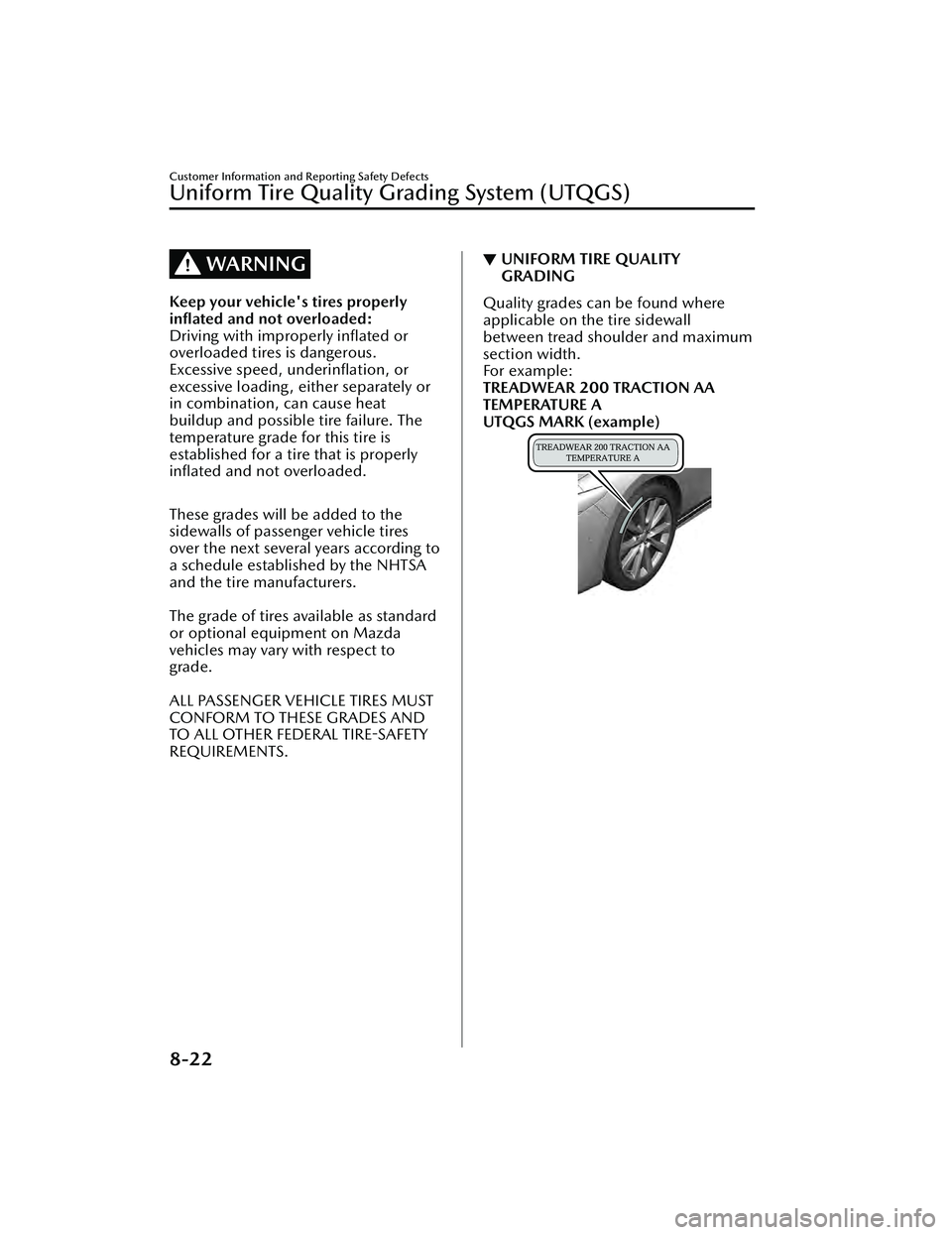
WARNING
Keep your vehicle's tires properly
inflated and not overloaded:
Driving with improperly inflated or
overloaded tires is dangerous.
Excessive speed, underinflation, or
excessive loading, either separately or
in combination, can cause heat
buildup and possible tire failure. The
temperature grade for this tire is
established for a tire that is properly
inflated and not overloaded.
These grades will be added to the
sidewalls of passenger vehicle tires
over the next several years according to
a schedule established by the NHTSA
and the tire manufacturers.
The grade of tires available as standard
or optional equipment on Mazda
vehicles may vary with respect to
grade.
ALL PASSENGER VEHICLE TIRES MUST
CONFORM TO THESE GRADES AND
TO ALL OTHER FEDERAL TIRE-SAFETY
REQUIREMENTS.
▼ UNIFORM TIRE QUALITY
GRADING
Quality grades can be found where
applicable on the tire sidewall
between tread shoulder and maximum
section width.
For example:
TREADWEAR 200 TRACTION AA
TEMPERATURE A
UTQGS MARK (example)
Customer Information and Reporting Safety Defects
Uniform Tire Quality Grading System (UTQGS)
8-22
Mazda3_8LC2-EA-22G_Edition1_new
2022-5-20 11:26:10
Page 583 of 623
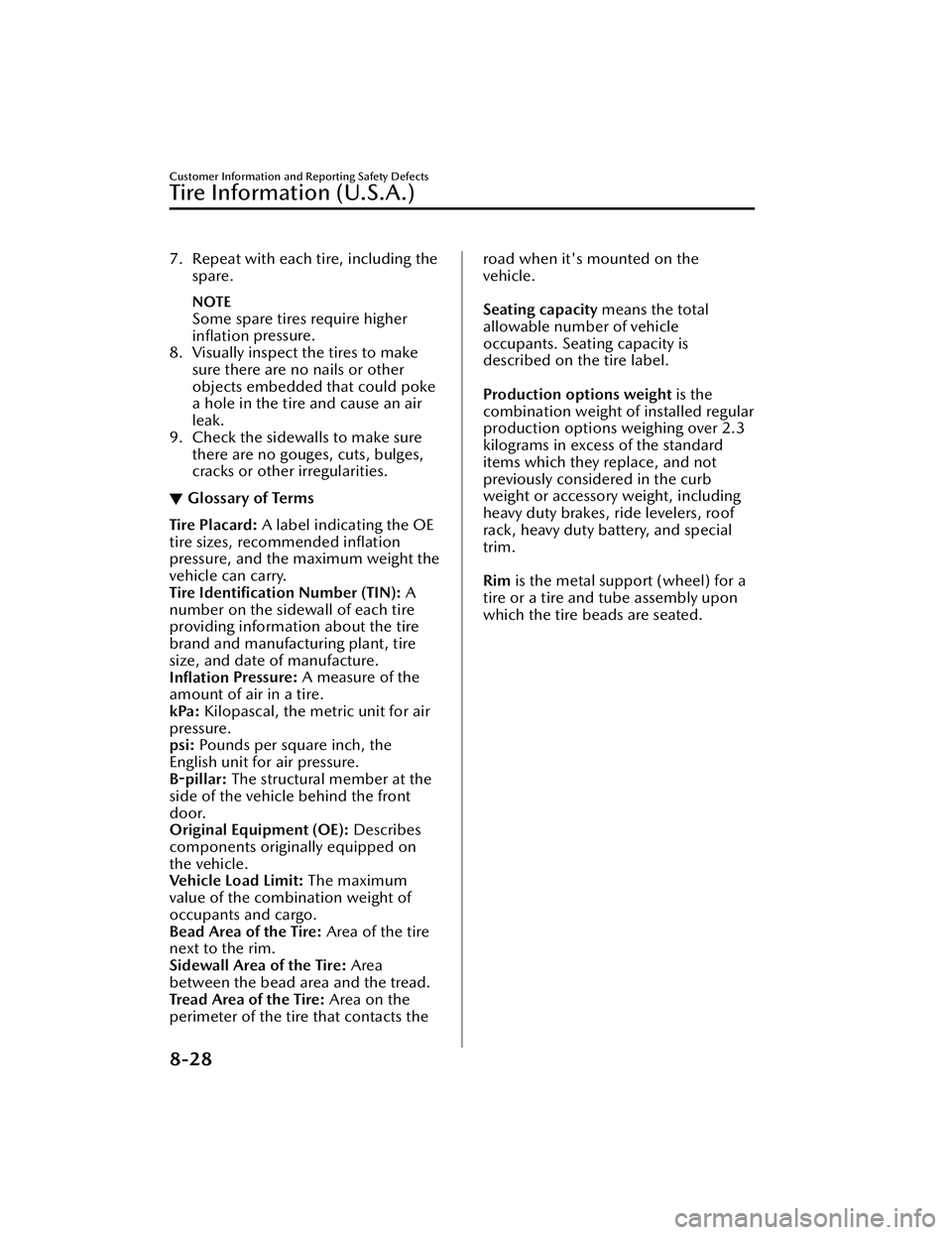
7. Repeat with each tire, including thespare.
NOTE
Some spare tires require higher
inflation pressure.
8. Visually inspect the tires to make sure there are no nails or other
objects embedded that could poke
a hole in the tire and cause an air
leak.
9. Check the sidewalls to make sure there are no gouges, cuts, bulges,
cracks or other irregularities.
▼Glossary of Terms
Tire Placard:
A label indicating the OE
tire sizes, recommended inflation
pressure, and the maximum weight the
vehicle can carry.
Tire Identification Number (TIN):
A
number on the sidewall of each tire
providing information about the tire
brand and manufacturing plant, tire
size, and date of manufacture.
Inflation Pressure:
A measure of the
amount of air in a tire.
kPa: Kilopascal, the metric unit for air
pressure.
psi: Pounds per square inch, the
English unit for air pressure.
B-pillar: The structural member at the
side of the vehicle behind the front
door.
Original Equipment (OE): Describes
components originally equipped on
the vehicle.
Vehicle Load Limit: The maximum
value of the combination weight of
occupants and cargo.
Bead Area of the Tire: Area of the tire
next to the rim.
Sidewall Area of the Tire: Area
between the bead area and the tread.
Tread Area of the Tire: Area on the
perimeter of the tire that contacts the
road when it's mounted on the
vehicle.
Seating capacity means the total
allowable number of vehicle
occupants. Seating capacity is
described on the tire label.
Production options weight is the
combination weight of installed regular
production options weighing over 2.3
kilograms in excess of the standard
items which they replace, and not
previously considered in the curb
weight or accessory weight, including
heavy duty brakes, ride levelers, roof
rack, heavy duty battery, and special
trim.
Rim is the metal support (wheel) for a
tire or a tire and tube assembly upon
which the tire beads are seated.
Customer Information and Reporting Safety Defects
Tire Information (U.S.A.)
8-28
Mazda3_8LC2-EA-22G_Edition1_new 2022-5-20 11:26:10
Page 586 of 623
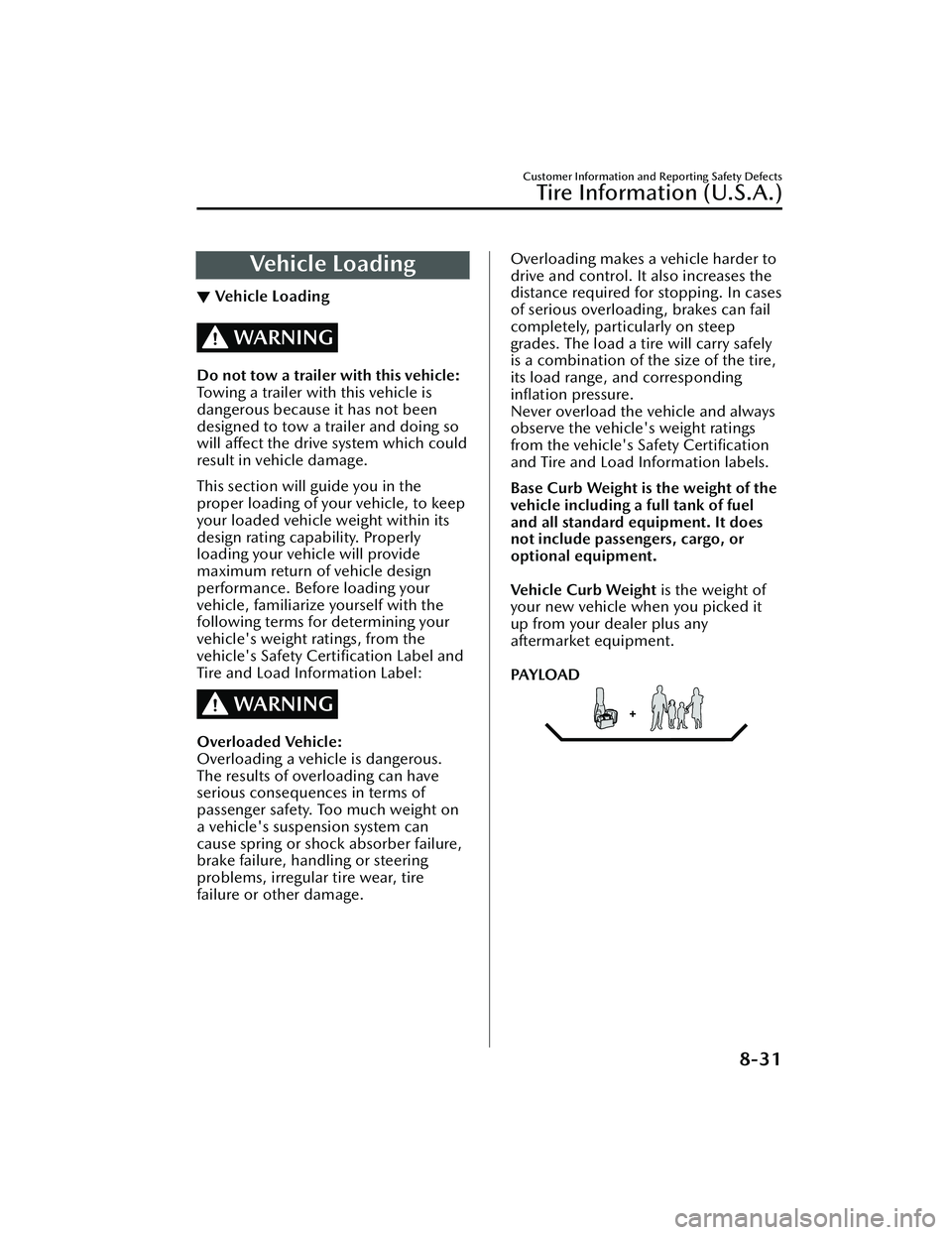
Ve h i c l e L o a d i n g
▼Ve h i c l e L o a d i n g
WARNING
Do not tow a trailer with this vehicle:
Towing a trailer with this vehicle is
dangerous because it has not been
designed to tow a trailer and doing so
will
affect the drive system which could
result in vehicle damage.
This section will guide you in the
proper loading of your vehicle, to keep
your loaded vehicle weight within its
design rating capability. Properly
loading your vehicle will provide
maximum return of vehicle design
performance. Before loading your
vehicle, familiarize yourself with the
following terms for determining your
vehicle's weight ratings, from the
vehicle's Safety Certification Label and
Tire and Load Information Label:
WARNING
Overloaded Vehicle:
Overloading a vehicle is dangerous.
The results of overloading can have
serious consequences in terms of
passenger safety. Too much weight on
a vehicle's suspension system can
cause spring or shock absorber failure,
brake failure, handling or steering
problems, irregular tire wear, tire
failure or other damage.
Overloading makes a vehicle harder to
drive and control. It also increases the
distance required for stopping. In cases
of serious overloading, brakes can fail
completely, particularly on steep
grades. The load a tire will carry safely
is a combination of the size of the tire,
its load range, and corresponding
inflation pressure.
Never overload the vehicle and always
observe the vehicle's weight ratings
from the vehicle's Safety Certification
and Tire and Load Information labels.
Base Curb Weight is the weight of the
vehicle including a full tank of fuel
and all standard equipment. It does
not include passengers, cargo, or
optional equipment.
Vehicle Curb Weight is the weight of
your new vehicle when you picked it
up from your dealer plus any
aftermarket equipment.
PAY LOA D
Customer Information and Reporting Safety Defects
Tire Information (U.S.A.)
8-31
Mazda3_8LC2-EA-22G_Edition1_new 2022-5-20 11:26:10
Page 606 of 623
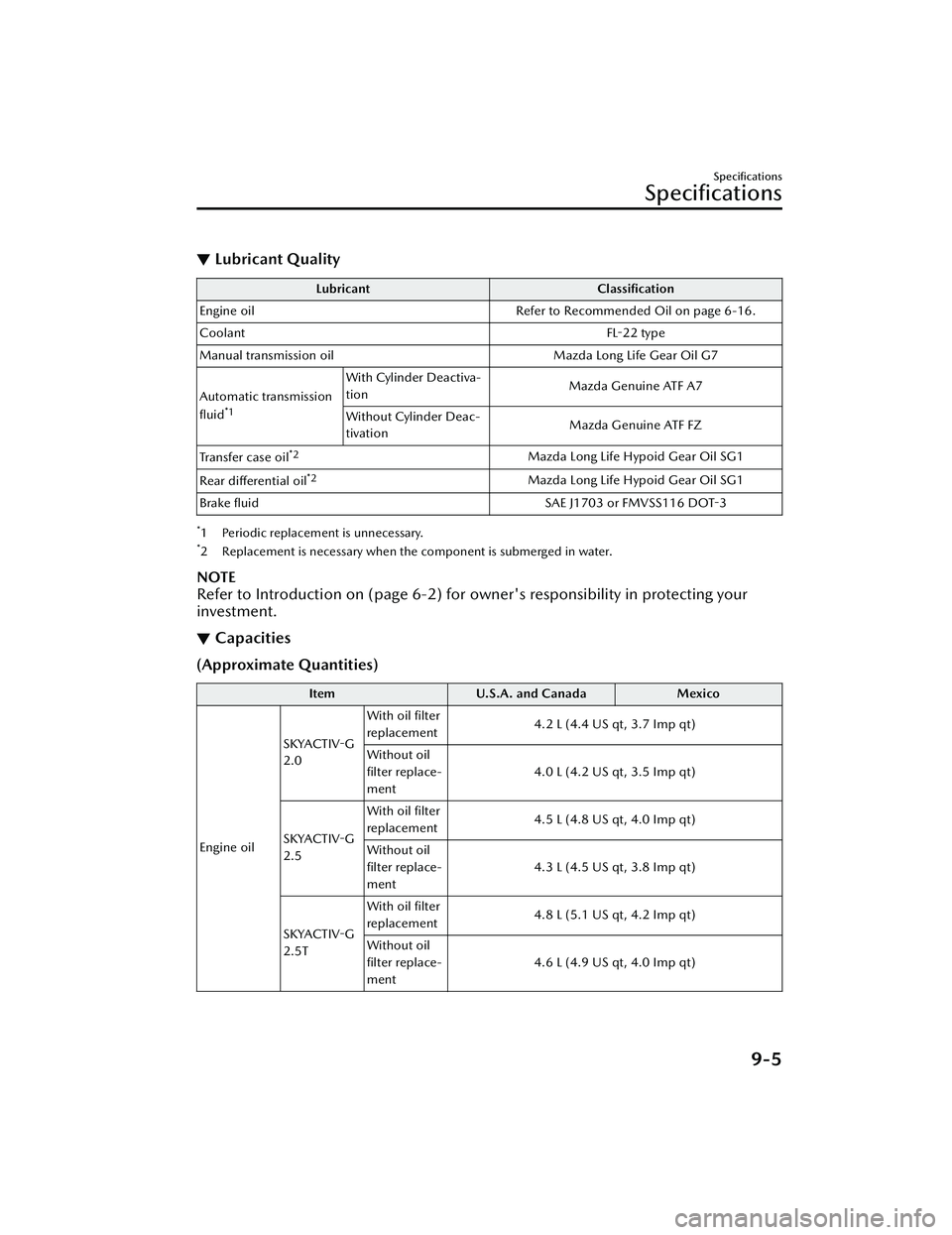
▼Lubricant Quality
Lubricant
Classification
Engine oil Refer to Recommended Oil on page 6-16.
Coolant FL-22 type
Manual transmission oil Mazda Long Life Gear Oil G7
Automatic transmission
fluid
*1
With Cylinder Deactiva-
tion Mazda Genuine ATF A7
Without Cylinder Deac-
tivation Mazda Genuine ATF FZ
Tra n s f e r c a s e o i l
*2Mazda Long Life Hypoid Gear Oil SG1
Rear differential oil
*2Mazda Long Life Hypoid Gear Oil SG1
Brake fluid SAE J1703 or FMVSS116 DOT-3
*1 Periodic replacement is unnecessary.*2 Replacement is necessary when the component is submerged in water.
NOTE
Refer to Introduction on (page 6-2) for owner's responsibility in protecting your
investment.
▼Capacities
(Approximate Quantities)
Item
U.S.A. and Canada Mexico
Engine oil SKYACTIV-G
2.0
With oil filter
replacement
4.2 L (4.4 US qt, 3.7 Imp qt)
Without oil
filter replace-
ment 4.0 L (4.2 US qt, 3.5 Imp qt)
SKYACTIV-G
2.5 With oil filter
replacement
4.5 L (4.8 US qt, 4.0 Imp qt)
Without oil
filter replace-
ment 4.3 L (4.5 US qt, 3.8 Imp qt)
SKYACTIV-G
2.5T With oil filter
replacement
4.8 L (5.1 US qt, 4.2 Imp qt)
Without oil
filter replace-
ment 4.6 L (4.9 US qt, 4.0 Imp qt)
Specifications
Specifications
9-5
Mazda3_8LC2-EA-22G_Edition1_new
2022-5-20 11:26:10